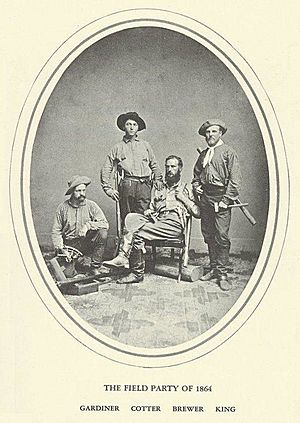Richard D. Cotter facts for kids
Richard D. Cotter (born September 17, 1842 – died March 12, 1927) was an important American explorer. He was born in Ireland and was also known as Dick Cotter. He was a key member of the first California Geological Survey, which explored and mapped parts of California.
Contents
Early Life and Adventures
Richard Cotter became an orphan when he was very young. In 1850, he moved to the United States from Ireland with his brother John. They were taken in by John C. Sutton, a blacksmith and farmer in St. Louis, Missouri. Mr. Sutton also invented a special plow. He made sure Richard and his siblings received an education.
When Richard was 18, he wanted to go west to find gold. Instead, he got a job with the California Geological Survey. This group explored and mapped California from 1862 to 1864. Richard worked as a packer, which meant he helped carry supplies. Even though he was new to packing, he learned very quickly.
Exploring the Sierra Nevada
Richard Cotter worked with famous explorers like Clarence King. King praised Cotter, calling him "our man-of-all-work." He said Cotter was strong, brave, and very dependable. Another explorer, Francis P. Farquhar, described Cotter as an "indomitable mountain-climber." This means Richard was incredibly determined and skilled at climbing mountains. His help was very important for their work.
In July 1864, Richard Cotter and Clarence King made a big discovery. They were the first to find Mount Whitney. This mountain is the highest peak in the lower 48 states of America.
Telegraph Expedition to Alaska
After his work in California, Richard Cotter joined another big project. In late 1864, he signed up for the Western Union Telegraph Expedition. The goal was to build a telegraph line from Asia, through Alaska, and across the Bering Strait. This would connect America to Europe.
In 1866, Richard Cotter and J.T. Dyer explored a dangerous area in Alaska. They successfully mapped the land between Norton Bay and the Koyukuk River on the Yukon. You can read Cotter's own report about this journey.
The telegraph project was stopped in July 1866. This happened because a new underwater telegraph cable was finished. This cable connected the United States directly to Europe. However, the expedition helped people learn more about Alaska. Many believe it helped convince the United States to buy Alaska from Russia in 1867.
Later Life and Legacy
After the Alaska project, Cotter worked with Clarence King again. This time, it was on the Geological Exploration of the Fortieth Parallel. He worked on this survey for two years. Then, he decided to settle down in York, a town near Helena, Montana.
In York, Richard Cotter had many different jobs. He was a Sunday School leader, a Postmaster, and even a Justice of the Peace. He also owned a mine and a Ranch.
Richard Cotter passed away on March 12, 1927, in Helena, Montana. He is buried in Forestvale Cemetery there.
Today, a mountain in Kings Canyon National Park is named after him: Mount Cotter. This mountain was named to honor his important contributions as an explorer.
Images for kids



